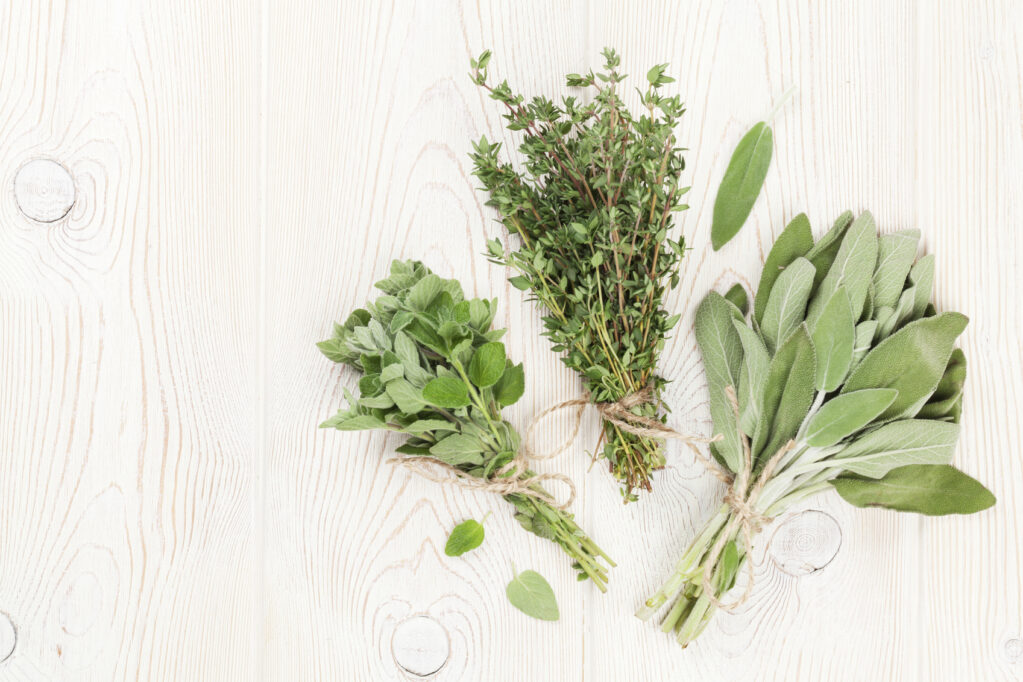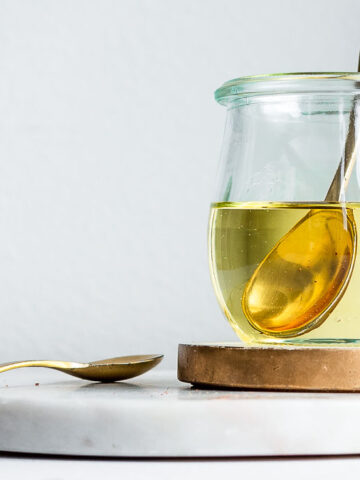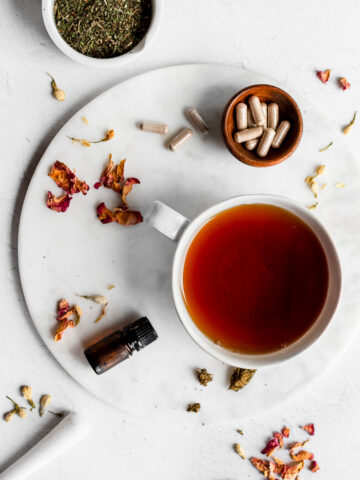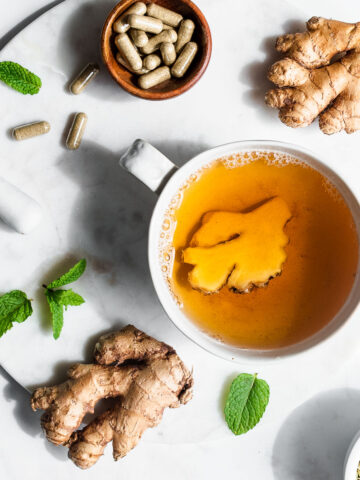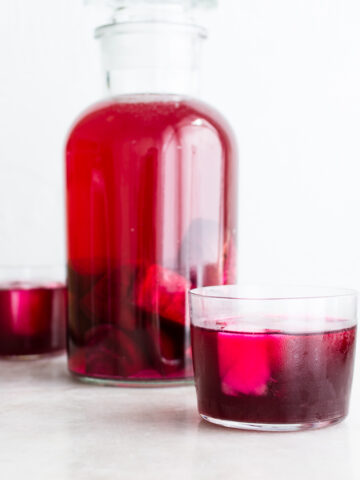I keep a little garden on my porch, where culinary and medicinal herbs fill terracotta pots. I toss these herbs, handfuls of basil and sprinklings of thyme, into soup pots, over salads and roasting chickens where they bring flavor and their sweet herbaceous perfume to the family meal.
While we enjoy their flavor and aroma, they bring more to the table than pleasure alone. Common culinary herbs also convey gentle medicine, traditionally used for purposes that range from stomach upset and headaches to colic and liver ailments. So, in many ways, my little garden of flavor is also a medicinal garden as well. Here's ten common culinary herbs, how to use them and their medicinal qualities.
Curly Parsley
Characteristics: Deep green, slightly serrated leaves that curl up from the stem with a potent fragrance reminiscent of carrot leaves and parsnips.
Flavor: Parsley offers a mild, but very clean flavor similar to that of parsnips.
Use it in: Braised Turnips with Parsley, Preserved Lemon and Parsley Tapenade, Cream of Chicken Soup, Springtime Salad
Medicinal Uses: Parsley's medicinal effects rest in its volatile oils and flavonoids: apiole, myristicin, terpinolene, appin and others. These components also account for parsley's notable flavor. Parsley is thought to offer therapeutic uses in the treatment of the urinary tract and is approved by Germany's Commission E - a therapeutic guide to herbal medicine - for use in the treatment of urinary tract infections as well as kidney and bladder stones. Traditionally, parsley was not only used for treatment of urinary tract and bladder infections but also as an treatment for gastrointestinal distress. Moreover, parsley is also used as a way to stimulate menstruation.
Bay Laurel
Characteristics: Native to the Mediterranean, bay laurel or sweet bay is tree with deep olive-green, oblong leaves that offer an unmistakable aroma.
Flavor: Sweet bay is rich and deep, faintly spicy.
Use it in: Bison Stew with Red Wine and Sweet Bay, French Onion Soup, Sour Pickles
Medicinal Uses: Bay is used medicinally as a stimulant for the skin, and, due to its volatile oils, may cause reddening in sensitive individuals.
Tarragon
Characteristics: Tarragon is a low-lying plant with long stems and thin oblong leaves. It has a flavor reminiscent of anise and is used often in French cooking.
Flavor: Tarragon offers a faintly anise- or licorice-like flavor - sweet and slightly stringent.
Use it in: Pan-Fried Chicken with Tarragon and Mustard Cream Sauce
Medicinal Uses: In folk medicine, tarragon has been traditionally used to treat toothaches, upset stomachs and some parents even used it to stave off intestinal parasites in their children. Much like parsley, tarragon has also been used as way to induce menstruation.
Basil
Characteristics: There are many varieties of basil, and basil can include many color variations, but most can easily identify the low-growing plant by its large, thin oval and easily bruised leaves.
Flavor: Basil is sweet, peppery and offers a slight anise-like aftertaste.
Use it in: Beet Salad with Basil, Clam Chowder
Medicinal Uses: Basil has strong antioxidant and antimicrobial activity. It is traditionally thought to stimulate the appetite and ease stomach upset. In Chinese medicine, basil is thought to support kidney function and ease gum ulcers. In classic Indian medicine, basil has been used to treat everything from earaches and itching to malaria, arthritis and anorexia. Like tarragon, one of basil's major volatile oils is estragole.
Dill
Characteristics: Dill can grow quite tall with beautiful, fragrant flowering heads and feathery, fragile leaves.
Flavor: Dill's flavor is slightly licorice-like, deeply fragrant and unmistakable.
Use it in: Salmon Chowder with Potatoes and Dill, Campfire Roasted Chicken with Flowering Onion and Dill, Potato Leek Soup with Dill, Sour Pickles, Shrimp Salad
Medicinal Uses: Dill and parsley share a commonality: apiole, that volatile oil that accounts for so much of their individual flavors. Dill is traditionally used to ease stomach upset and to treat gastrointestinal disorders. In folk medicine, it is also used to treat sleep disorders - particularly insomnia. Some parents give a dill infusion or tea to their young babies as a treatment for colic.
Lavender
Characteristics: Lavender is a low-lying bushy flower with long stems and many tiny, pale purple buds.
Flavor: Lavender is faintly floral and very herbaceous with green overtones.
Use it in: Four Thieves Vinegar, Sleepy Tea
Medicinal Uses: Lavender is approved by Germany's Commission E for loss of appetite, insomnia and circulatory disorders. In folk medicine, it is often used to treat migraine, cramps, restlessness and sleep issues.
Oregano
Characteristics: Oregano is a short, shrubby herb with small, deep-green leaves. The leaves have a kind of soft and almost fuzzy texture.
Flavor: Oregano is bold, deep and strong and the fresh herb is considerably stronger than in its dried form. It is deeply herbaceous and slightly similar to thyme with faint mint-like undertones.
Use it in: Roasted Lamb with Olives, Lemon and Fresh Oregano
Medicinal Uses: Oregano is traditionally used to treat respiratory issues such as stuffy noses and coughs and is an expectorant. In folk medicine, it is also used to treat menstrual cramping and it has very potent antimicrobial activities.
Sage
Characteristics: Sage is a low-lying, silvery bush with oblong, soft and fuzzy leaves.
Use it in: Turkey Hash with Yam and Sage, Chicken Liver Pâté with Sage
Flavor: Sage has a slightly medicinal flavor that is very herbaceous with slight grassy undertones. It is deeply fragrant.
Medicinal Uses: Sage is approved by Commission E to improve appetite and to ease inflammation, particularly of the mouth. For nursing mothers who may be experiencing over-production, sage can help to slow milk production.
Rosemary
Characteristics: Rosemary is a pine-like shrub with long stems and short, needle-like leaves.
Flavor: Rosemary is pine-like in its scent with almost floral undertones. It is deeply aromatic.
Use it in: Crispy Rosemary Roasted Potatoes, Braised Steak with Red Wine and Rosemary, Sourdough Focaccia with Rosemary and Grapes, Toasted Almonds with Rosemary, Thyme, and Lemon
Medicinal Uses: Rosemary is traditionally used for digestive upset and to ease headaches and migraines. It's also used to treat menstrual disorders and, externally, is used to speed healing in wounds and to treat eczema. Germany's Commission E has approved rosemary for use in blood pressure problems, digestive upset and rheumatism.
Peppermint
Characteristics: Peppermint is a bushy plant characterized by its long stems, and bright green, slightly fuzzy leaves.
Flavor: Peppermint is very aromatic and one of the most loved of the mint family.
Use it in: Strawberry Mint Sorbet, Spring Risotto, Vanilla Mint Ice Cream, Strawberry Yogurt Bowl with Mint and Pine Nuts
Medicinal Uses: Mostly taken as a tea or in infusions, peppermint is traditionally used to treat colic and digestive upset, but it's also been popularly used in the treatment of colds, flus and stuffy noses thanks to its ability to open the sinuses and, in combination with honey, to ease a sore throat. Peppermint essential oil, when applied to the temples, is thought to help with headaches and migraines. Peppermint leaves have been approved by Germany's Commission E in the treatment of liver and gallbladder complaints.

